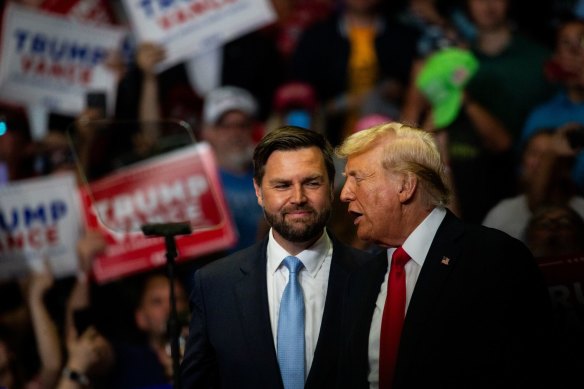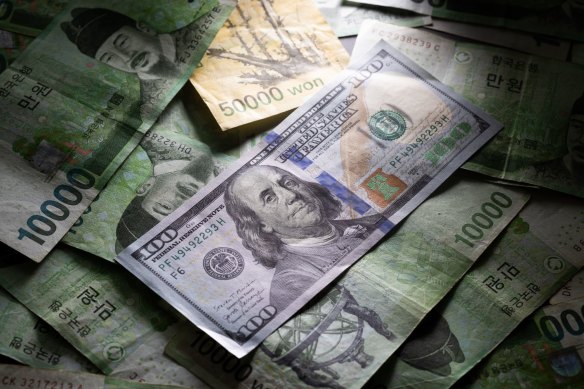Opinion
Trump’s deluded desire for a lower US dollar
Stephen Bartholomeusz
Senior business columnistThe desire of Donald Trump and his running mate J.D.Vance to have a weaker US dollar underscores how confused and contradictory, and potentially destabilising for the US and the world, the economic elements of Trump’s re-election platform are.
In a recent interview with Bloomberg, Trump claimed the US had a currency problem.
“The depth of the currency now in terms of the strong dollar, weak yen, weak yuan, is very massive,” he said. Trump added the strong dollar was a “tremendous burden” on US companies trying to sell their products abroad.

Donald Trump with J.D. Vance at Saturday’s (Sunday AEST) campaign rally at Grand Rapids, Michigan.Credit: Bloomberg
Vance is also an advocate for a weaker dollar, arguing in a Senate hearing last year that the dollar’s status as the world’s reserve currency was a subsidy for US consumers but a tax on US manufacturers.
“I know that the strong dollar is sort of a sacred cow of the Washington consensus but, when I survey the American economy, and I see our mass consumption of mostly useless imports on the one hand and our hollowed-out industrial base on the other I wonder if the reserve currency status also has some downsides, and not just upsides as well,” he said.
Former Trump economic advisers like former trade chief Robert Lighthizer, the architect of Trump’s trade policies in his previous administration, are reportedly devising ways to devalue the dollar, either via US actions or via a new Plaza Accord with other countries, using the threat of more tariffs as leverage.
In 1985, with the greenback soaring against its major trading partners’ currencies and the US trade deficit blowing out, the Reagan administration called the UK, Germany, France and Japan to a meeting at the Plaza Hotel in New York to agree to use their foreign currency reserves to achieve a forced devaluation of the US dollar.
In that instance the threatened use of tariffs was effective, although the accord had minimal impact on US manufacturing activity and manufacturing jobs which continued to decline.
Trump, Vance and some of Trump’s advisers have a fixation with trade deficits and role that a strong US dollar plays in their size. They see trade, simplistically, as a zero-sum game.
Trump’s tariffs on China and Europe and others in his first term were a response to his conviction that America was being ripped off by its trading partners.
He plans to double down on a strategy that had little impact on the overall trade deficit – it simply shifted some imports from China to third countries – by imposing a 10 per cent universal baseline tariff on all imports and a 60 per cent duty on all imports from China.
Presumably a second Plaza Accord, if that were the option adopted to try to force a depreciation of the dollar, would involve threats of even higher tariff rates.
Other actions that could be taken to devalue the dollar would be to instruct the Fed to print dollars and sell them (which the Fed would be most unlikely to agree to) or to direct the US Treasury to raise more debt and use it to buy third currencies. Capital controls would be another option.

A strong US dollar is an affirmation of America’s economic strength and the currency’s “safe haven” status.Credit: Bloomberg
The dollar has been strong this year although, having risen about 4 per cent on a trade-weighted basis against the currencies of America’s major trading partners, it has weakened over the past month to be up only 2 per cent for the year.
The greenback has been relatively strong for an obvious reason. US real interest rates have been relatively high as the Federal Reserve Board has maintained rates at their highest levels for decades, even as the US inflation rate has slowly subsided.
The higher returns, a strong US economy and the Biden administration’s massive incentives for green manufacturing, domestic semiconductor plants and critical minerals have all attracted inflows of foreign capital and strengthened the dollar.
In other words, the strong dollar is an affirmation of American economic strength and, in a volatile geopolitical and geoeconomic environment, of its “safe haven” status for global savings.
If Trump regains the presidency, apart from another bout of tariffs that will probably provoke a retaliatory response from America’s trading partners, including its allies, he plans to extend the tax cuts for companies and the wealthy he enacted in his first term that expire next year.
The estimated cost to the budget is $US4.5 trillion. He’s ruminated about new and even deeper tax cuts. He has also flagged a massive crackdown on illegal immigration and the detention and deportation of undocumented immigrants already within the US.
All those policies would reduce economic growth and would, in combination, be seriously inflationary.
The Fed, unless neutered by Trump (some of his advisory groups have been working on plans for that), would be forced to push US rates up, which would in turn almost certainly lead to the dollar strengthening – the policies he advocates are a recipe for a higher dollar.
A weaker dollar, if it could actually be artificially engineered, would import inflation, force interest rates higher and make US exports more competitive but imports more expensive.
Despite Trump and Vance’s focus on manufacturing and manufacturing jobs (and votes), it represents - directly and indirectly - less than 25 per cent of US GDP. Personal consumption expenditures represent about 68 per cent of GDP – the US economy is consumption-driven.
His hoped-for weaker dollar would, if it could be achieved, help some exporters (who generate about 10 per cent of US GDP) but punish consumers, particularly low-income households.
It would also undermine the dollar’s status as the world’s reserve currency, which would not only lead to higher borrowing costs in the US but undermine the dollar’s dominance, which gives it geopolitical power.
The sanctions that the West has imposed on Russia, or the US has imposed on some Chinese companies and individuals, are only possible because of the dollar’s dominance of trade, finance, central bank reserves and the international financial systems and markets.
If a Trump administration were able to lower the dollar’s value against its major trading partners, they would inevitably take action to protect their own economies, whether by raising their own trade barriers (which they might do anyway in response to Trump’s trade policies) or by buying US dollars or raising their own interest rates or a combination of all of the above.
Open economies like Australia’s, reliant on resource exports, would face lower revenues and profits and lower taxation revenues in a low-dollar world, although some developing economies, laden with dollar-denominated debt, might regard a weaker dollar as beneficial.
A tit-for-tat trade and financial environment would be destructive for global growth and economic and political stability, as well as US hegemony. A deliberately weakened dollar, which in the context of Trump’s agenda could probably only occur if the Fed lost its independence, would also impact on flows of capital towards the US.
With a fiscal deficit running at $US2 trillion a year and US government debt of $US35 trillion and rising towards 116 per cent of GDP within a decade, America needs relatively higher real interest rates and a strong dollar to entice foreign investors to buy its debt.
Trump and Vance and some of their advisors don’t appear to understand the likely unintended consequences of the individual economic and taxation policies they espouse, let alone the interactions and conflicts between them if all of them were implemented.
If Trump and the Republicans were to win in November, there would be massive uncertainty and volatility injected into the global economy if the US embraces Trump and Vance’s protectionist and isolationist tendencies – whether or not they delivered the lower trade deficits and weaker dollar that they wish for.
The Business Briefing newsletter delivers major stories, exclusive coverage and expert opinion. Sign up to get it every weekday morning.